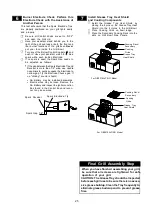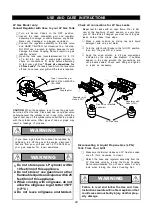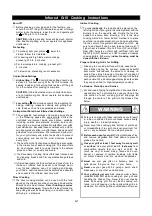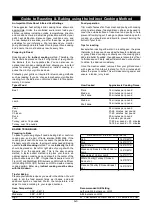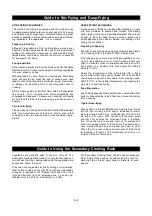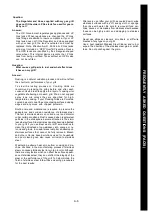
A-4
DEEP-FRYING TECHNIQUES
A wide variety of foods can be deep-fried outdoors on your
grill, from potatoes, to seafood and chicken. Deep-frying
uses a large portion of oil, preferably saturated. The outdoor
location is ideal for deep-frying as smoke, grease and
smells disperse in the open air instead of collecting on the
ceiling of your kitchen.
Preparing to Deep-fry
Deep-fry on your grill using an optional cast-iron pan placed
on a Cooking Grid in the path of direct infrared heat.
Fill a cooking pan no more than half full of vegetable or corn
oil. Turn the grill Burners on HI, close Lid and preheat your
grill 3 to 5 minutes. Open Lid and place cast-iron pan on the
mid section of a Cooking Grid then adjust the Infrared
Burners to LOW.
Check the temperature of the oil carefully with a frying
thermometer or test with a cube of bread. The cube of bread
should brown in about 30 seconds for most cooking needs.
350°F(177°C) is the optimal temperature for preparing the
majority of deep-fried foods.
Food Preparation
Foods being deep-fried taste better when coated with either
batter or breadcrumbs to add flavor and prevent moisture
from escaping.
Tips for Deep-frying
W ear a flame retardant BBQ Mitt and slowly lower foods
into the hot oil using a wire scoop, fry-basket or stain-
less steel tongs. Add only a small quantity of food to the
oil, allow it to cook, then repeat with another small
quantity. This ensures the oil doesn't drop in tempera-
ture. Once the food is cooked, remove it carefully and
drain onto a paper towel. Turn the heat off as soon as you
have finished deep-frying and allow your pan to cool.
W hen the oil is cool, remove all remnants of fried foods
by straining it through a fine metal sieve, and store it in
a clean bottle for future use.
STIR-FRYING TECHNIQUES
This method of cooking is popular around the world and can
be easily accomplished outdoors on your gas grill. It's a quick
and healthy way of preparing a complete meal using meat,
poultry or seafood in infinite combinations with other interest-
ing ingredients like vegetables, rice or noodles.
Preparing to Stir-fry
Although it is possible to stir fry in other dishes, a wok is your
best tool. Its high sides enable the cook to stir food without
spillage. Its construction allows you to cook quickly at high
temperatures, with instant control of heat which is essential
for successful stir frying.
Food preparation
Slice meat and poultry into long thin strips and cube fish fillets.
Remove all fat from meat and poultry and cut large vegetables
into even slices or cubes.
Marinate foods for extra flavor and tenderness. Marinating
times will vary for red meat, fish and or various cuts. Less
tender cuts of meat should be marinated longer. Remember
to always chill marinating food in the refrigerator prior to
cooking.
Stir-fry meats, poultry or fish first. Next, add hard vegetables
like carrots. Then continue with softer vegetables like
snowpeas and peppers. To ensure even cooking, continually
stir and toss the food in the wok using a wooden spoon or
spatula.
Tips for Stir-frying
Place a wok on a Cooking Grid in the path of direct infrared heat.
Add only a small amount of food at a time to ensure fast
cooking and also to allow the wok to reheat between ingre-
dients.
Vegetables are generally easy to cook on the grill. The
Secondary Cooking Rack makes it convenient because you
can still use the main cooking area while the vegetables are
suspended above the grids.
Pre-cook hard vegetables by briefly boiling or microwaving
them before cooking on the grill. Do not grill your vegetables
wrapped in aluminum foil. Infrared heat does not cook
through aluminum foil and reflective pans. To keep veg-
etables moist, brush them with butter or oil often.
Guide to Using the Secondary Cooking Rack
The Secondary Cooking Rack can be used for purposes
other than just the obvious. Consider using the rack for
warming French bread, garlic bread, croissants or even
bagels.
Guide to Stir-Frying and Deep-Frying


